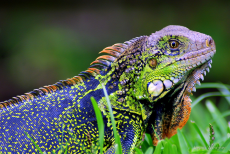
Iguana is a genus which, in the scientific categorisation of animals called ‘taxonomy’, comes one above a species. The genus includes two different species, the green iguana and the Lesser Antillean iguana, both of which are herbivorous lizards native to tropical areas of Mexico, Central America and the Caribbean.
This genus is in turn a member of the Iguanidae family, another taxonomic term. Members of this family include the marine iguana, which is only found in the Galapagos Islands. It forages for food in the sea, and can dive over 9m down. Another Iguanidaes are the Fiji crested and banded iguanas, the most geographically isolated iguanas in the world. These iguanas are the totem, or spirit animals, of some Fijian tribes, which means that their names cannot be spoken in front of women. Spinytail iguanas from Mexico and Central America are also Iguanidaes, and it was a Spinytail who achieved the world sprint record for a lizard, at 21.5 miles an hour! Rock iguanas from the West Indies are also record breakers: an iguana named Godzilla was brought to Gladys Porter Zoo in Texas in 1950 from the Cayman Islands. After 54 years of captivity it died in 2004 at the age of 69, making it the longest living lizard recorded in history.
Iguanas can grow between 5 and 6 feet long, including their tails which actually make up the majority of their length. They have a flap of skin below their lower chins called dewlaps. These help to regulate the iguana’s body temperature and are also used in both courtship and territorial displays as the dewlap can be extended to make the lizard appear much larger than it actually is. Iguanas have incredible eyesight, and are capable of detecting shape and motion at very long distances. They have few rod cells in their eyes, which means they have poor vision in low light conditions. However, they have many cone cells, which gives them very sharp colour vision and even enables them to see ultraviolet wavelengths. Iguanas also have a ‘third eye’ on their heads. This light-sensing organ is called a parietal eye, and is visible as a pale scale between their other eyes. It can detect changes in brightness but cannot see any fine details.
Green iguanas, also known as common or American iguanas, even have a fourth eye of sorts. Large round scales on their cheeks, known as Subtympanic shields, fool predators into thinking they have huge eyes—making them harder to sneak up on. They also help to break up the iguana’s shape in foliage. This is useful as iguanas are arboreal, which means they live in or among trees. They are very agile climbers and can fall up to 50 feet and land unhurt. Iguanas are herbivorous, which means they only eat plant matter and have very sharp teeth to help them shred leaves. The first dinosaur discovered had similar flat serrated teeth and so was named the Iguanodon, or Iguana-tooth. Iguanas are often found near water, and can swim using broad strokes of their strong tails. These can also be used for defence, striking at predators with a whipping motion. If an iguana’s tail is grabbed it can safely break off and allow the animal to escape and regenerate another later.
Green iguanas actually come in many different colours. In southern countries they tend to be bluish, with bold blue markings. Iguanas in the Caribbean islands range from green to lavender, black and pink, whilst Costa Rican and Mexican iguanas are red and orange. These colours, as well as the Green Iguana’s calm temperament, make them popular pets. However, they are very difficult to care for properly, as they require a specific diet. Iguanas must also be kept between 26 and 35 degrees Celsius, and need a source of UVB and UVA light to get sufficient Vitamin D.
Image: http://ih0.redbubble.net/image.8471067.8785/flat,1000x1000,075,f.jpg

0 Comment:
Be the first one to comment on this article.